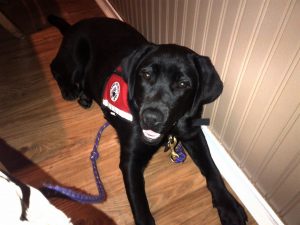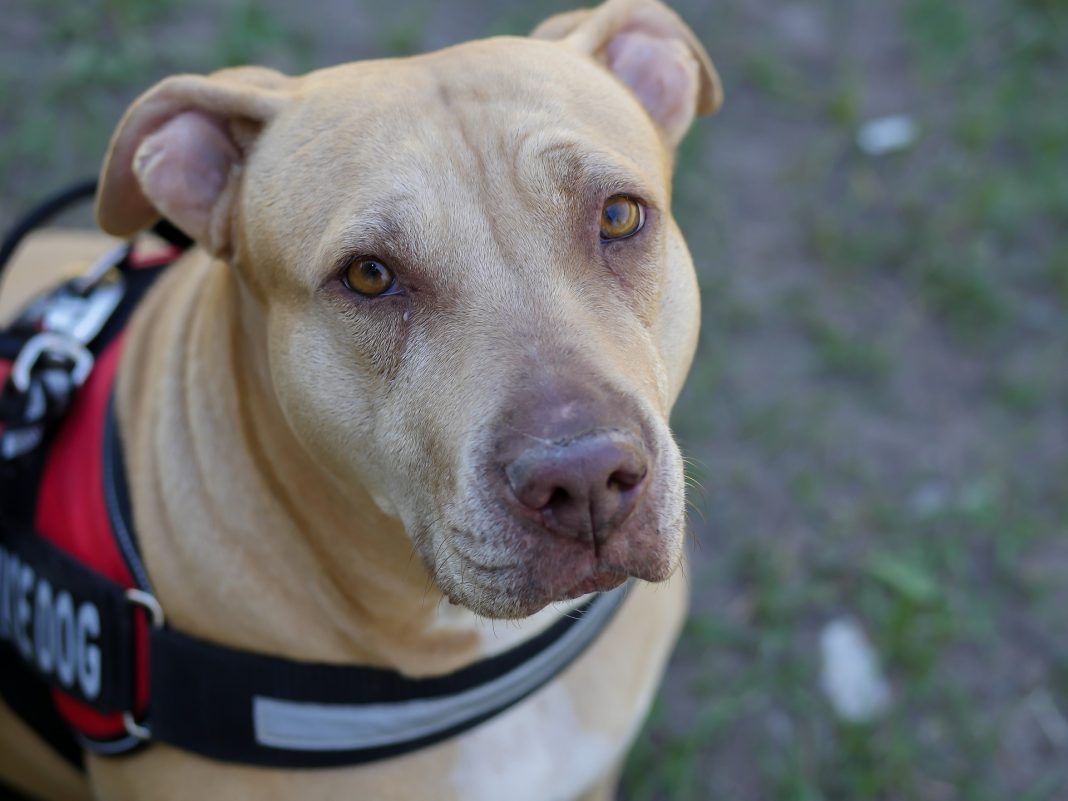Stern faces and medals of valor litter the halls of a government building in Roanoke, Virginia. Past the pictures and paintings of memorable military personnel and a sign warning passers-by of what lies beyond the office doors, sits a man and his dog — well, not his dog — who today, like every Friday, are experiencing a little more foot traffic than usual. Most are here to see Nasya, a golden and black labrador retrieaver mix less than a year old who, according to her trainer Jon Yost, is “wicked smart” and more obedient and steadfast than pets thrice her age.
In most cases, pets are not allowed in public offices, especially in the thick of government operations. Yost knows this; he’s already been tasked to deal with an Inspector General complaint — which is kind of a huge deal —against a co-worker’s own service animal in training. Yost resolved the tension without much issue. The dog remained unabashedly unphased.
“I couldn’t figure out how it wasn’t the right thing to do,” said Yost. “Being a good wingman for vets [veterans] and kids is right in line with Air Force core values. Plus, federal and state laws did not preclude it. Neither did Air Force regs. Believe me, I checked.”
But Nasya was different than just another pet, because she knew even at four months old that she had a job to do, earning this public-access privilege because of months of intensive training and a vest marked with two distinctive phrases synonymous with her profession: “do not pet” and “service animal.”
The history of domesticated animals goes back at least 6,400 years, tracing its roots to partnerships between the human population and the East and West Eurasian wolves. Those facts can and are disputed but one thing cannot be, that animals as pets fill some sort of innate need for companionship.
However, using those same animals in a service aspect is a relatively new concept. In the United States, the first school to train seeing eye dogs for the blind was opened in 1929, and it was the only training facility of its kind for many years. Training dogs to perform professional tasks aside from leading the blind didn’t emerge until the 1960s. The legal definition of a dog operating in a service capacity wasn’t defined until 1990 in the Americans with Disabilities Act (ADA), and even then it was only labeled “any guide dog, signal dog or other animal individually trained to provide assistance to an individual with a disability.”
Now, under stricter but more encompassing ADA standards, a service animal is defined as a dog that has been individually trained to work or perform tasks for an individual with a disability. These include physical, sensory, psychiatric, intellectual or other mental disabilities but across the board the service provided by the dog must be “directly related” to the person’s disability.
“Here’s the thing, and it’s an important thing,” said Yost. “These animals have to be absolutely bulletproofed from a behavior and obedience point of view because if they are distracted from their environment, they cannot do their job. If they cannot do their job, their kid or veteran can come to serious harm.”
Before she turned one, Nasya could support the weight of a 200-pound grown man, turn her nose to qualify for seizure alert and be completely professional in public. While most pups her age learned to sit and shake and possibly roll over, Nasya learned how to, simply, be perfect.
Essentially, on paper, the difference between a pet and a service dog comes down to those hundreds of hours of training. While the specific training is different from one organization to another, legitimate trainers and certifiers adhere to the standards and expectations set by Assistance Dogs International, the governing body for the assistance dog industry. According to Melissa Winkle, President of Animal Assisted Intervention International and Dogwood Therapy Services, there are three kinds of assistance animals -guide, hearing and service -and the training organizations for each have their own evaluations for their animals.
While guide dogs for the sight or hearing impaired are often recognizably associated with their handler’s physical disability, service animals come under the most scrutiny because of the more recent inference of emotional support animals. The companies that “certify” ESAs are often not regulated or standardized and use the “service animals” they churn out to turn a massive profit.
According to Alice Smith from PAWS Training Centers [which is now Compass Key], there are many scam organizations online that people use to purchase vests for imposter service dogs. Anyone can purchase these vests to give the illusion to the public that their pet is actually a service dog.
This has led to an abundance of fake service animals which have not only blurred the lines for what a service animal legally is but also disrupts the environments in which fully accredited dogs work and have access to.
Service dogs (SDs) and emotional support animals (ESAs) are quite different. SDs are required to do work or tasks to assist with the disability. ESAs help just by being there, no training required. SDs are required to behave well in public, and have the right to go in public practically anywhere with their disabled handler. ESAs are not required to be trained to behave in public, and as such are not allowed out in public no-dog places.
A support animal provides help like a support stocking that someone wears. It helps just by being there. A service dog provides a service — in other words they are working for someone.

“A service dog is definitely not the right choice for everyone,” said Veronica Morris, president of the Psychiatric Service Dog Partners. “We recommend that the person make a list of all the ways their disability limits them that they want help with. Then brainstorm using other service dog users and/or trainers to figure out what the dog can do to help. Then the person should make sure that the drawbacks of a service dog are worth the help the dog might provide in those areas. None of this is required, but it does help in thinking about if someone should get a service dog.”
The service dog versus emotional support animal debate has caused waves in the media recently. A student flushed her emotional support hamster down the toilet after she was told it wasn’t allowed on a plane; another woman and her emotional support peacock were turned away from their flight. A company called Service Dogs by Warren Retrievers sold customers $25,000 dogs allegedly trained to alert to spikes or dips in blood sugar when in reality they were “little more than incredibly expensive pets.” Questions will continue to surround the issue because of the vague legal definitions and regulations in place.
As recently as May 5, 2018, 21 states have pushed legislation that would crack down on those who falsely claim their pets as assistance animals so they can bring them into restaurants or other locations previously reserved for humans and certified service dogs. In Minnesota, Gov. Mark Dayton signed into law a bill “making it illegal for people to misrepresent their pets as service animals” and would subject those guilty to a $100 fine and a misdemeanor charge; Arizona Gov. Doug Ducey signed a similar bill that would fine guilty parties $250.
The issue crosses party lines and everyone seems to agree that this has become a silent epidemic affecting those that need the most help in society. But while there are laws in place or being put in place, that doesn’t necessarily mean there is a solution. According to YouTube videos posted by Drew Lynch, a comedian with a service dog, who is often vocal in the debate over service animal regulations, he often encounters discrimination from those that believe his service dog is fake. During one routine hotel check-in, the manager was adamant that Lynch was required to carry papers for his dog, but even when Lynch explained the legality behind the accusations, the manager was having none of it.
“It’s emotional support animals that have to have their paperwork,” explained Lynch. “Full service dogs are not necessarily given paperwork with their certification, and, some handlers don’t carry it.” Lynch continued, “Legally, you’re only allowed to ask me two questions. Is that a service dog? And what service does she provide? You haven’t asked me either of those.”
While the interaction as described by Lynch was not only confrontational but explicit discrimination, the hotel manager was operating under the now common assumption that anyone can “slap a vest” on a dog and call it a service animal. He reacted the same way many in the hospitality industry are to this upturn in ESAs. Dogs in $25 vests bought off Amazon look identical their highly-trained, hyper-focused, life-saving counterparts; the only difference is the behaviors and intuitions of the latter. The misuse of the service dog label for emotional support animals ultimately deliberately disrespects both the countless hours of training that go into the process and the reputation those dogs have earned through with via their profession. Because, at the end of the day, all service dogs can be pets but not all pets can be service dogs.
Nasya spent months with Yost and his family, who picked up training service animals after their family dog Beco died. In a way, she filled the pet void that remained, even though Yost knew from the beginning she was not a pet.
“From day one these are not pets,” said Yost. “They’re working dogs. They have to earn everything: a walk, water, food, playtime, affection.”
Nasya developed a love for “thousands of cubic centimeters of cheese” treats and used her time off from working engaged in the occasional fit of tug-of-war. She enjoyed naps and snuggles as much as the next dog. Even the Yost’s second service dog in training, a golden retriever named Jolie, would come in from frolicking alongside Jon while he cut the grass with green paws.
When it came time for Yost to hand his dogs off to their next trainer — the final stop before the leash was transferred to their permanent handler — it was always difficult, as they’d become part of the household. But it never took long for him to remember that the dog had a job to do, and they’d completed their job as trainers.
“We took immense pride in the fact that, according to the organization’s professional trainers who taught the final stages of the animals’ curriculum, our dogs were the best, the most solidly bulletproof, they’d seen,” said Yost. “Made all the effort and time worthwhile.” Nasya and Jolie both took their bulletproofing and became seizure alert dogs for children with severe epilepsy. Their training allowed them to detect the physiological change in their handler’s body chemistry, giving those caring for the child precious time to prepare for or prevent a seizure altogether. Both dogs also knew a handful of “party tricks” so that they’d help with the social aspects of the child’s life as well.
“Well sure, self-sacrifice does often require some, you know, sacrifice,” said Yost. “The day you pass the leash to their forever handler is a crushingly sad day. But it’s not your animal. The animal in whom you’ve invested countless hours training and sharing and bonding belongs to someone whom you’ve not met yet and need them far more than you do.”























